
29.02.2020
Auch wenn es die letzten Tage sehr wechselhaftes Wetter hatte, gab es am frühen Morgen klarer Himmel welche uns Gestern am 28.02.2020 zwei weitere Meldungen über unsere Tel-Hotline erreichten welche auf die Starlink-Satelliten zurückgeführt werden konnten. Die Meldungen kamen aus:
Erftstadt bei Köln und Düsseldorf.
Wie stark sich inzwischen die Meldungen verursacht durch die Starlink-Satelliten bei unserer UFO-Meldestelle zeigen, ergibt sich bei unserer Auswertung der Melde-Eingänge von 2019, welche wir bei unserer Statistik mit fast 60% aufweisen:
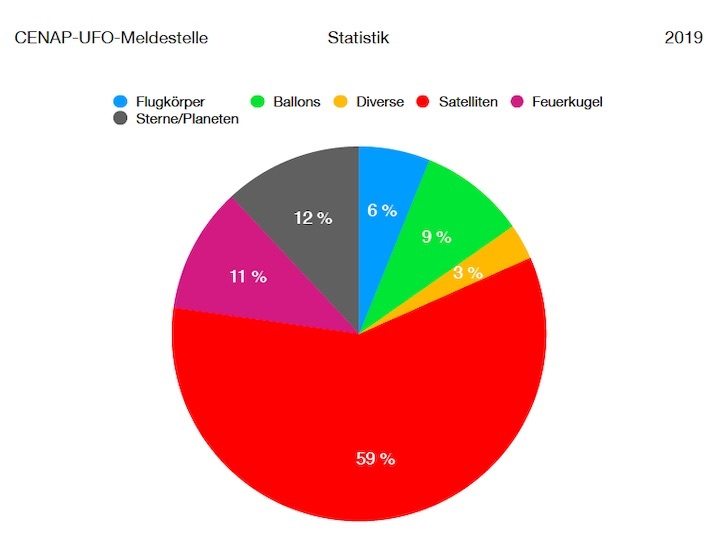
Statistik 2019: https://www.hjkc.de/_blog/2020/02/28/14734-ufo-forschung-cenap-ufo-meldestelle-statistik-2019-im-zeichen-der-starlink-satelliten/
CENAP-Michelstadt
+++
Interessant ist auch nachfolgender Artikel aus Discover in welcher NASA nach Handy-Aufnahmen von den Überflügen der Starlink-Satelliten sucht:
.
NASA Wants You to Photograph Starlink Satellites With Your Smartphone
SpaceX and others plan to launch thousands of new satellites into low-Earth orbit, creating streaks that cut through astronomers’ images. Now NASA’s education office is asking citizen scientists to help document the problem.
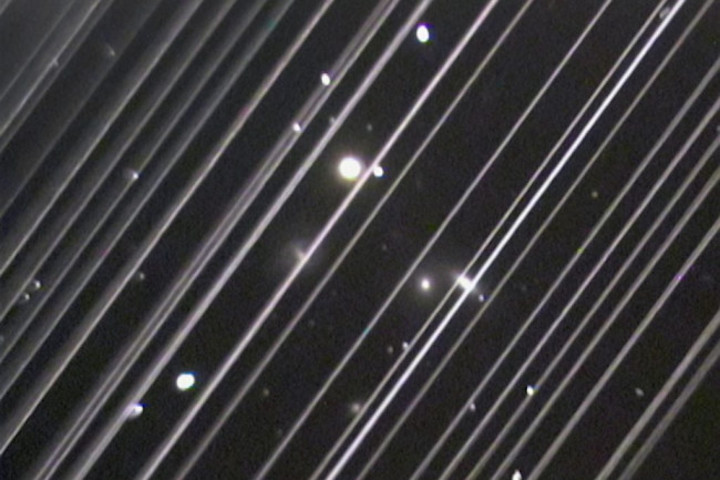
Telescopes at Lowell Observatory in Arizona captured this image of galaxies on May 25, their images marred by the reflected light from more than 25 Starlink satellites as they passed overhead. (Credit: Victoria Girgis/Lowell Observatory)
Over the coming years, Elon Musk’s private spaceflight company, SpaceX, will launch thousands of small satellites as part of an effort to provide global, space-based internet. But with each launch, astronomers have grown increasingly worried that this satellite constellation, called Starlink, will interfere with their telescopes’ abilities to study the night sky. This week, scientists with the Russian Academy of Sciences announced that they’ll take their concerns about Starlink to the United Nations, Newsweek reported.
And now NASA’s education office has launched a project that asks for the public’s help documenting these satellite streaks as part of a long-term effort to study how the technology will change our night sky. Anyone with a modern smartphone and a tripod can contribute to the Satellite Streak Watcher project.
“People will photograph these Starlink satellite streaks, and we’ll collect a large archive of these over time,” says astronomer Sten Odenwald, Director of Citizen Science for the NASA Space Science Education Consortium. “It’s going to document the degradation of our night sky by these low-Earth orbit satellites.”
Fight Against Light Pollution
Astronomers have been losing the fight against light pollution for decades. Increasingly powerful lights from streetlamps, sports complexes, businesses and homes reflect their radiation into the night sky, washing out the stars. Light pollution increases about two percent each year in both areas lit and the brightness of that light, according to a 2017 study. The public is already documenting these changes through citizen science projects that measure light pollution.
But until recently, the attention has typically focused on the ground.
That started to change with the first few launches of Starlink satellites. Astrophotographers and amateur astronomers immediately noticed these spacecraft streaking across the sky. The streaks are particularly prominent just after launch, when the satellites are still bunched together. Some skygazers have compared it to a “string of pearls” drifting across the night sky.
Many satellites are visible from Earth in the hours after sunset and before sunrise, when sunlight reflects off their surfaces and solar panels. The closer a spacecraft is to Earth, the brighter it appears to those looking up.
SpaceX's satellites stand apart because of their shear volume and low orbit.
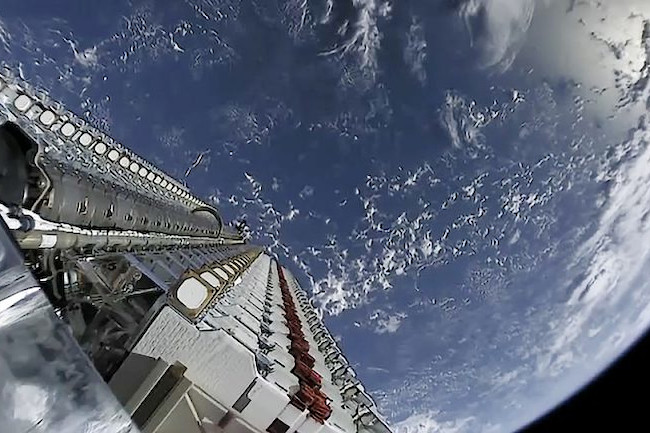
Satellite Internet Constellations
To beam internet connectivity back to Earth, many of these will have a shallow orbit. There also has to be thousands of them to provide global coverage. By the time SpaceX is finished, the company could have as many as 40,000 new spacecraft in orbit. They’ve already announced plans to launch 60 satellites every other week through 2020. For comparison, there are currently just over 2,000 total satellites in orbit right now. SpaceX isn’t the only company with visions of dominating satellite internet, either. A handful of competitors, including Amazon, intend to launch their own constellations.
For its part, SpaceX has started experimenting with low-reflectivity materials to coat the satellites. However, from an engineering perspective, satellites need reflective materials to keep cool.
“The problem is made worse because the satellites are in low-Earth orbit,” Odenwald says. “They’re brighter because they’re lower. And because there are so many of them, it means (astronomers) get maybe as much as an hour of bright streaks going across their sensitive photographic detectors.”
Those numbers are the real worry for scientists. Astronomers have already moved their telescopes to increasingly remote locations to avoid light pollution. But there’s nothing they can do to avoid bright satellites streaking through and ruining their images.
Cell Phone Astronomy
Odenwald says that inspired him to launch the Satellite Streak Watcher project and ask citizen scientists all over the world to take pictures of these satellites with their cellphones.
To take part, you’ll need a very basic tripod and a reasonably new smartphone. The veteran astronomer says he’s been amazed at the quality of night-sky images now coming from smartphones. Many phones are now sensitive enough to capture the Milky Way, and he’s even seen detailed shots of the International Space Station taken by holding a phone up to a telescope eyepiece.
“If you’ve got a new phone, it’s probably good enough to do this, and several of them have night sky modes, which is perfect,” he adds. Even phones dating back to 2016 or so should be able to photograph these satellites in about four seconds.
You’ll want to master your phone’s long exposure or night sky setting before heading outside. On older iPhones, you can also capture a Live image and set the exposure to 10 seconds. These work differently than traditional DSLR cameras, which leave the shutter open to capture longer exposures, but the end result is very similar.
You’ll also need to know when the satellites are passing overhead. To find out, you can go to Heavens-Above.com and enter your location. The website will give you a list of satellites and the times that they’re passing over your region. Setup your tripod in advance and point it at the region you want to photograph, then wait for the satellite to appear. To upload your images, simply go to the Satellite Streak Watcher project website and include your exposure and the background constellation.
Even astrophotographers with DSLRs are welcome to contribute. They should use a lens wide enough to capture a broad swath of the night sky, but not one that’s so wide it distorts the field. About a 50mm lens should be perfect.
All-Sky Survey
Odenwald says there’s not a clearly defined scientific end goal at the moment. Rather, he’s hoping to document these streaks for a five-year period so that one day, astronomers can tap into the photos and study how satellite streaks have changed over time.
Throughout the history of astronomy, all-sky surveys -- traditionally done with much larger telescopes -- have proven pivotal to a broad range of research, he points out. And the ways those images proved useful wasn’t always anticipated by the astronomers who gathered them.
“We could have 5,000 to 10,000 of these satellites buzzing around low-Earth orbit at some point,” Odenwald says. If nothing else, “you could do before and after photos to show how much more annoying the sky is than it used to be.”
Quelle: Discover
+++
LIGHT FROM ELON MUSK'S STARLINK SATELLITES RUINS SPACE PHOTOS, SAYS RUSSIAN GOVERNMENT AGENCY
Russia's Academy of Sciences will complain to the United Nations about the light reflected from the Starlink satellite system, saying it interferes with the work of astronomers, it has been reported.
Batches of satellites continue to be sent up into orbit to work with ground transceivers with the aim of providing greater broadband internet access on Earth, especially in areas where connections are harder to get, or more expensive.
Lifted up on SpaceX's reusable Falcon 9 rocket, the first Starlink launch took place on May 23, 2019, and the project is a key part of billionaire Elon Musk's cosmic plans.
But Nikolai Samus, a researcher from the Russian academy, said the network of hundreds of satellites reflects light from the sun and can corrupt between 30 to 40 percent of astronomical images.
According to state-run news agency RIA Novosti, the Russian academy's concerns are shared by colleagues from the European Space Agency and it will take them to the U.N.
Samus told an audience at the Moscow planetarium, "We are currently drafting a letter (for the U.N) from the Royal Academy and tomorrow we will discuss this issue with our vice president Yuri Balega. Such a letter will come from us."
Last month, a batch of 60 Starlink satellites were launched, bringing its constellation to 300 satellites, according to Tech Crunch, which reported that they could be providing internet access to the U.S. and Canada by the middle of 2020.
But concerns have been raised before about the impact of Musk's Spacelink plans which would add potentially thousands of satellites into orbit, increasing the risk of creating space debris.
The head of the Russian defense company Vympel, Sergey Boev has expressed concerns that the Starlink system could be used for military purposes, Russian media reported.
He believed it was cause for alarm that the newly-appointed commander of the U.S. Space Force, John Raymond, had met with Musk to discuss how the the satellites could help the Pentagon, according to Russian outlet news.ru.
Last October, Reuters reported that the U.S. Air Force program Global Lightning is using the network to test encrypted internet services for military planes.
Russia has previously taken issue with Musk's plans, accusing SpaceX of pushing it out of the carrier rocket market. Moscow announced in September 2019 it would build its reusable Argo rocket to compete with Musk's Falcon 9 rockets.
Russia hopes it can supply the International Space Station [ISS] by 2024, with domestically produced rockets, according to the RBC news website.
Quelle: Newsweek
+++
Thousands more SpaceX satellite chains on the way
The sparkling satellites seen across New Zealand skies will only become more common as space becomes "more like the wild west", a scientist says.
American entrepreneur Elon Musk's SpaceX has been launching Starlink satellites in batches of 60 since May last year and has about 300 orbiting Earth.
The satellite chains have come in for criticism from astronomers worldwide because it reflects sunlight creating light pollution.
Duncan Steel, a space scientist based in Nelson, said space had become "lawless".
"Apparently they're planning to have 12,000 up before too long and they're aiming for 42,000 within the next few years, and they're not the only nation doing this.
"I'd say in some ways space is becoming a bit like the wild west, somewhat lawless and certainly these things will cause problems for ground based astronomy - optical because of the reflection of sunlight and also radio astronomy because of the light radiant pollution."
Steel said there was no enforceable regulation to stop companies like SpaceX from launching as many objects as they can into orbit as the United Nations are "powerless".
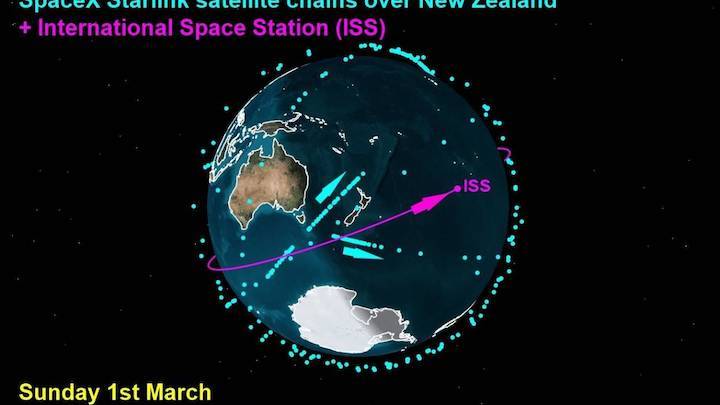
"There's nothing to stop them from doing this. To actually launch something you need permission from your nation because there are various UN treaties with regards to the use of space and the UN has a specific office to deal with this - Space Affairs as its called in Vienna, but it doesn't have any power."
"So these companies get licensed by the launching nation to put things into space then there's nothing that can be done to stop them as such. It's like saying UN has rules which preclude warfare but it doesn't mean to say there's no wars."
Steel said launching too many satellites into space would create another problem with space debris causing collisions due to congestion.
"From my own perspective rather than ground based astronomy I see a problem in terms of space debris for reparation. The problem of satellites colliding with each other or debris from satellites colliding with other satellites.
"That clearly is going to get worse and worse as time goes by and we put more things into orbit."
On Saturday evening, the SpaceX satellites are expected to cross New Zealand's sky at about 9pm while the International Space Station (ISS) will be crossing at about 9.59pm.
"They're very easy to see, they can be as bright as most of the stars," said Steel.
"You will see them moving in groups so they're kind of moving in step.
"The space station is very very bright. This space station is the size of a rugby field while these SpaceX satellites are the size of a table."
On Sunday, the International Space Station will passes south of New Zealand at about 9.15pm and can be seen from throughout New Zealand.
The Starlink satellites will be visible to the naked eye between about 9pm and 9.45pm on Sunday evening.
"(The ISS) will appear as bright as the very brightest stars in the sky," Steel said.
"As the sky darkens and your eyes get better adjusted, you should be able to see dozens of them (SpaceX satellites), each taking about seven or eight minutes to pass from the western horizon to the eastern side of NZ, though the precise positions in the sky depends on where you are located."

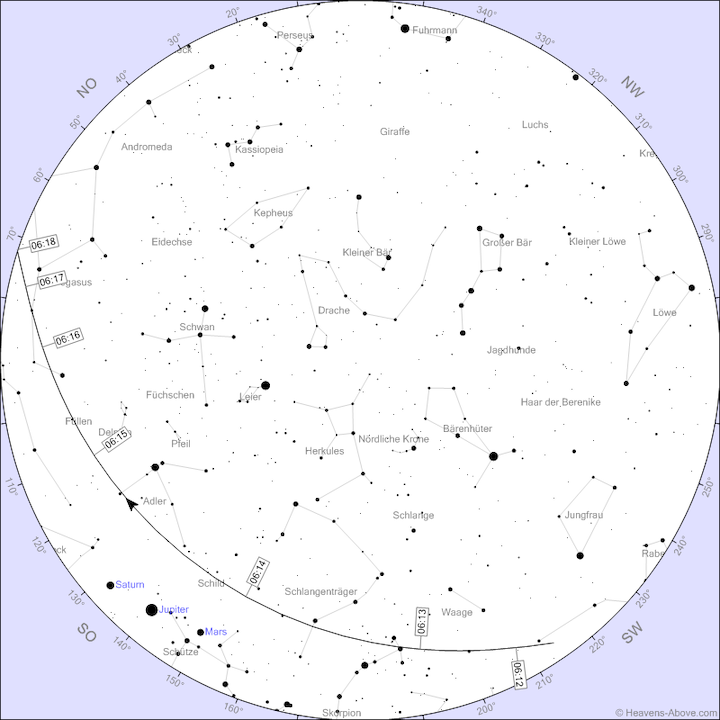

Sichtung am 11.03.2020 in der Zeit von 05:15 bis 05:40 Uhr
Standort 26556 Schweindorf Breitengrad 53,60807 Längengrad 7,474879
Blickrichtung 53.36.13,612 N 7.28.29,8 E 220 Grad SW
Sternenklar teilweise Schleierwolken
Bewegung deutlich schneller als Verkehrsmaschinen.
In diesem Zeitraum zogen aus Richtung 220 Grad SW Richtung Ost über 50 nicht zu
identifizierende Lichtpunkte über den Himmel. Diese Objekte flogen in fast gleicher Linie
mit jedoch unterschiedlichen Abständen zu einander. Als Anhaltspunkt, aus Bodensicht
zogen diese Objekte etwa 18 cm am äußeren Stern des großen Wagen (Benetnasch)
vorbei. Durch die teilweise vorhandenen Schleierwolken konnte ich sehen das sich
diese Lichtpunkte unterhalb der Wolken befanden.
Wir haben hier sehr viel Flugverkehr am Himmel. Aber dadurch, dass wir uns hier auf
dem platten Land befinden, sind Umweltgeräusche so gut wie nicht vorhanden. Dies
ermöglicht die Fluggeräusche von Flugzeugen, selbst aus etwas größerer Entfernung,
wahr zu nehmen.
Von den wahrgenommenen Objekten gingen jedoch keine Geräusche aus obwohl sie
fast direkt über meinen Standort hinweg zogen.
Meine Sicht zum Nachthimmel wird durch keinerlei Bauwerke etc. eingeschränkt und
beträgt je nach Richtung bis zu sicherlich 20+ Kilometer.
Die Luftwaffenstandorte Wittmund und Jever dürften für diese Erscheinungen nicht16
relevant sein.
+++
Am Abend erreichten uns Tel-Anrufe zu Starlink-Satelliten aus:
Bremen-Arsten, Bomlitz
Stand: 20.00 MEZ
CENAP-Michelstadt
----
Update: 16.03.2020
.

16.03.2020
Da die Präsenz der Starlink-Satelliten sich nun aufteilen auf die Morgen- und Abendstunden, erreichen uns Beobachtungsmeldungen aus ganz Deutschland, jeweils zu guten Beobachtungsbedingungen bei klarem Himmel. Anmerkung: Alle Beobachter kannten die Starlink-Satelliten trotz der letzten Medien-Berichte nicht!
15.03.2020 Abend: Lohmar, Lennestadt, Montabaur,
15.03.2020 Morgen: Bondorf, Reutlingen,
16.03.2020 Morgen: Seelbach/Westerwald, Speyer, Meisenheim
Stand: 17.00 MEZ
CENAP-Michelstadt
+++
16.03.2020 Abend:
Nachricht: => heute gegen 20:30 27 Flugobjekte über Cottbus in sehr großer Höhe aus Richtung Berlin in Richtung Ost Süd Ost
CENAP-Michelstadt
----
Update: 17.03.2020
.

17.03.2020
Auch Heuteabend gingen weitere Meldungen zu den Starlink-Satelliten bei unserer Tel-Hotline ein. Inzwischen taucht die letzte Staffel als Perlenkette auf und die voraus gesandten Starlink-Satelliten als aufgelöste Gruppierungen.
Westlich von Berlin konnte über Wustermark die Perlenkette von über 50 Satelliten wahrgenommen werden:
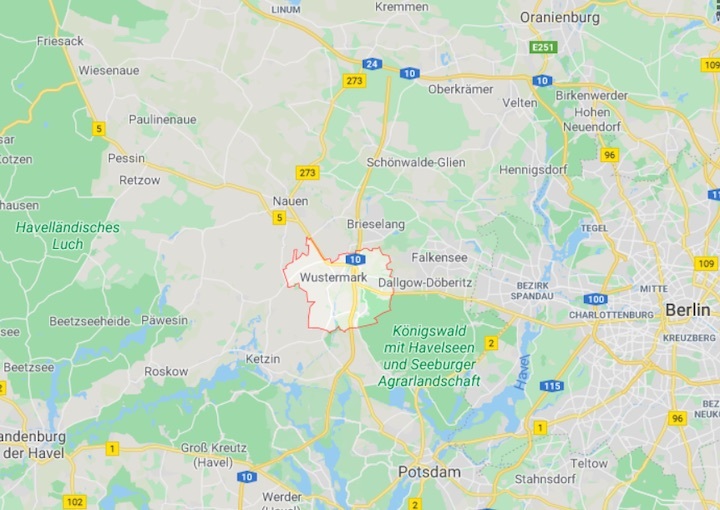
+++
Weitere Beobachtungen bekamen wir aus:
Schneeberg, Sondershausen, Eschwege, Wetzlar, Ludwigsburg
Stand 22.00 MEZ
CENAP-Michelstadt
----
Update: 18.03.2020
.

18.03.2020
Über unsere Tel-Hotline gingen auch Heuteabend Meldungen Betreff Starlink-Satelliten ein.
Beobachtungen kamen aus.
Wuppertal-Vohwinkel, Kassel, Mainz, Bonn.
Stand 21.00 MEZ
CENAP-Michelstadt
----
Update: 19.03.2020
.

19.03.2020
Gesternabend herrschten in fast ganz Deutschland beste Bedingungen für klaren Himmel mit Folgen für unsere UFO-Meldestelle. Über den ganzen Tag hinweg gingen E-Mail´s und Tel-Anrufe ein mit klaren Beschreibungen von Lichterketten, Lichterformationen, unzählige rasch über den Himmel ziehender Sterne usw. welche alle auf die Überflüge der Starlink-Satelliten zurück zu führen sind. Aus nachfolgenden Beobachtungsorten gingen Meldungen ein:
Düsseldorf, Köln, Bad-Reichenhall, Tübingen, Meerbusch, Neuss, Breckerfeld, Drolshagen, Bad Honnef,
Bornheim, Meuspath, Dachsenhausen, Greberhain, Gotha, Kirchlauter, Ingelfingen, Brackenheim,
Malsch, Herxheim, Maikammer, Dannenfels,
Stand: 16.15 MEZ
CENAP-Michelstadt
----
Update: 27.03.2020
.

27.03.2020
Am heutigen Abend kamen bei unserer UFO-Meldestelle per Tel sowie E-Mail Beobachtungen von "Sternformationen welche über den Himmel zogen" und "Lichtpunkte wie Satelliten" rein. Alle Beobachtungen konnten wir auf die Überflüge der Starlink-Satelliten zurück führen.
Meldungen kamen aus:
Bad-Reichenhall, Aschau im Chiemgau, Tacherting und aus Faistenau/Österreich
Stand: 20:30 MEZ
CENAP-Michelstadt
----
Update: 28.03.2020
.

28.03.2020
Viele Anrufe und E-Mails erreichten uns heute Abend wieder zu den Starlink-Satelliten aus ganz Deutschland sowie auch aus Österreich.
Nachfolgend Auszüge der E-Mails:
Sehr geehrte Damen und Herren,
vor ca.10-15 Minuten haben mein Freund und ich ca.40 Flugzeuge(?!) in Kolonne am Himmel
gesehen.
Zur aktuellen Corona Zeit wo der Flugverkehr so gut wie zum Erliegen gekommen ist
erscheint uns das ganze etwas merkwürdig.
Die Flugzeuge flogen direkt über uns Leun Limburger Straße 57 in Richtung Aßlar im fast
exakten Abstand zu einander.
Wir kennen leider die Himmelsrichtungen nicht wirklich.
Ich habe es mehrfach gefilmt.
3 der Flugzeuge(?) flogen neben einander.
Ich rief direkt eine Freundin an und die hat es ebenfalls gesehen.
Vielleicht könnten Sie uns dazu was sagen?!
Mit freundlichen Grüßen
M.H.
+++
Sehr geehrt und Herren,
gerade haben meine Frau und ich etwas sehr ungewöhliches gesehen.
Wir wohnen in Bad Lippspringe und haben gerade uns den schönen Sternenhimmel
angesehen, da sahen wir
60 helle Punkte wie Sateliten, die hintereinander und nebeneinander in relativ nahem
Abstand über unser Haus von Süd nach Nord flogen
Alle Punte flogen alle in die gleiche Richtung und fast alle in gleichem Abstand.
So etwas haben wir noch nie gesehen.
Das können doch keine Sateliten sein??!!
Was kann das gewesen sein.
Normalerweise sieht man an klaren Abenden in längeren Abständen 3 ,4, oder 5,die aber in
unterschiedliche Richtung fliegen.
Was war das????????
Über eine Antwort würde ich mich sehr freuen, Danke
Mit freundlichem Gruß
W.V.
+++
Nachricht: => Habe gerade wohl die Starlink Satellitten beobachtet. Ort Pfarrwerfen in
Salzburg Österreich. Zeit ca 20..45h. Das ungewöhnliche, es waren mehrere mMg. nach
mindestens 4 andere Flugobjekte die den Starlink Kurs folgten dann jedoch in verschiedene
Richtungen südlich bis südwestlich Kursänderungen vornahmen und dann weiter in linearer
Flugbahn so weit ohne Fernrohr erkennbar, flogen. Waren das BegleitFlugzeuge??? in diser
Höhe? es ist bei uns zur Zeit wg. Covid kaum Flugverkehr zu beobachten und lt. Flugradar
und dgl. auch keine Zivilmaschinen geflogen. Was waren das für Flugobjekte (nicht die Musk
Satelliten)?
Lg Maxco.
+++
Über unsere Telefon-Hotline erreichten uns Beobachtungen aus:
Brühl, Baden-Baden, Karl am Main, Menzendorf, Grevesmühlen, Gummersbach, Bochum 2x, Rodgau-Dudenhofen, Mainz, Wetzlar, Herrenberg, Lahr, Saarbrücken, Grünstadt, Speyer, Karlsruhe, Roggendorf, Thomasburg, Wesendorf, Bockenem, Bad-Langensalza, Bad-Orb, Krautheim, Maulbronn,
Balingen,
Stand 22.30 MEZ
CENAP-Michelstadt
----
Update: 29.03.2020
.

29.03.2020
Weitere Beobachtungen erreichten uns am frühen Morgen zu den Starlink-Satelliten Überflügen von Gestern aus Berlin-Schönefeld, Borkheide und Wittenberg.
Aus Leun bekamen wir die versprochenen Handy-Video zugesandt welche wir als Referenz-Aufnahmen verwenden dürfen und aus denen die nachfolgenden Screenshots sind:
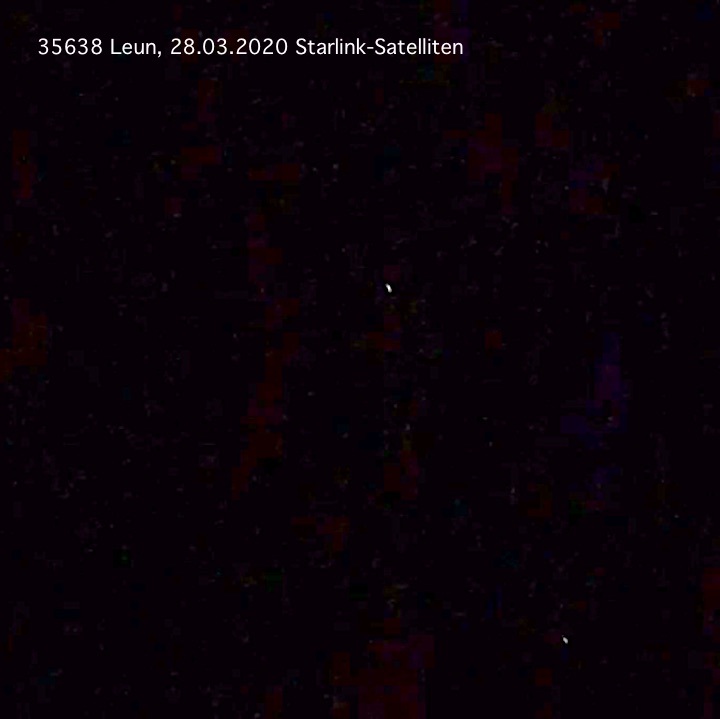
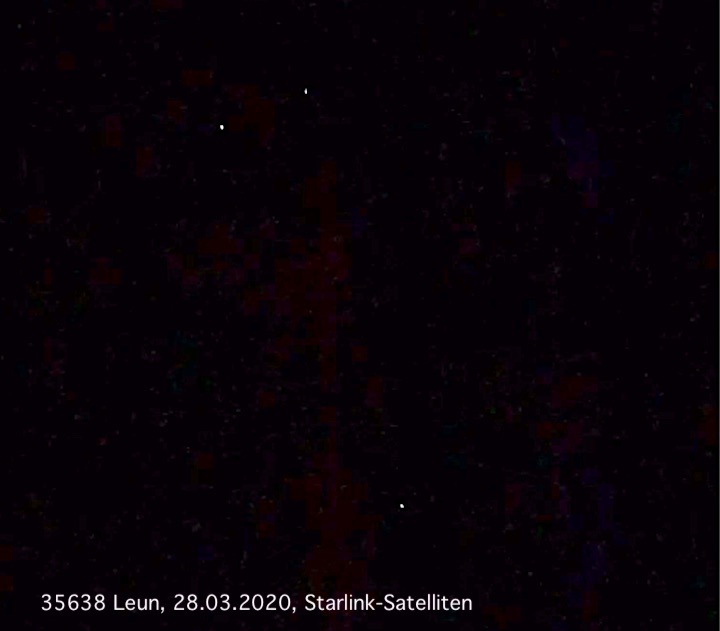
Auf der zweiten Aufnahme kann man schön die versetzten Starlink-Satelliten erkennen welche nicht mehr nur hintereinander wie Perlenkette fliegen, sondern auch nebeneinander.
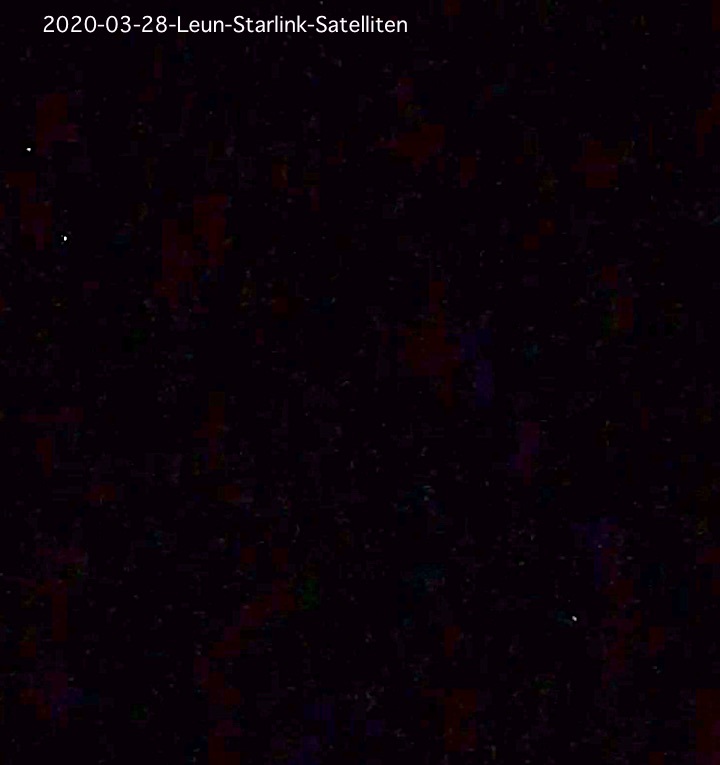
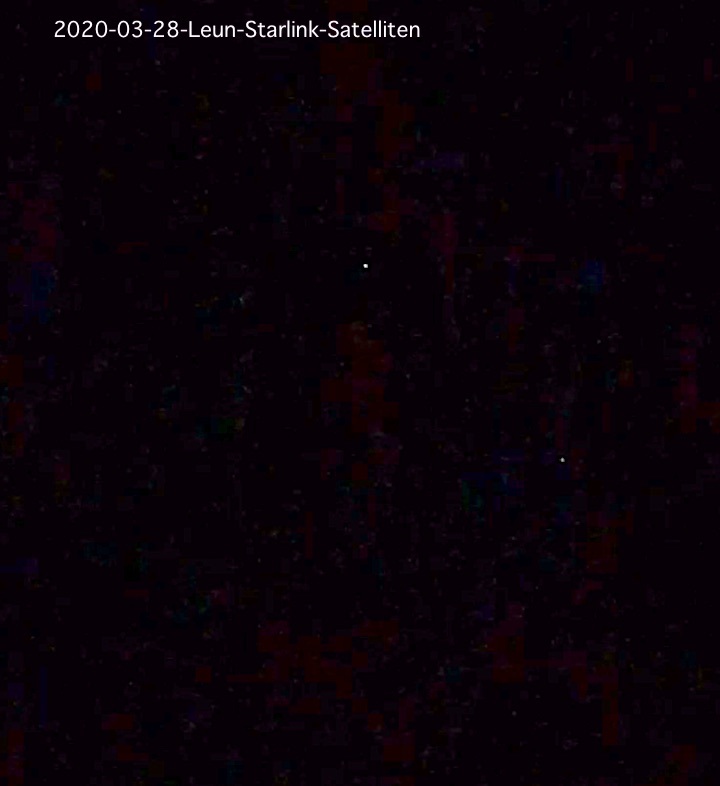
Stand 9.00 MEZ
CENAP-Michelstadt
+++
Update: 11.00MEZ


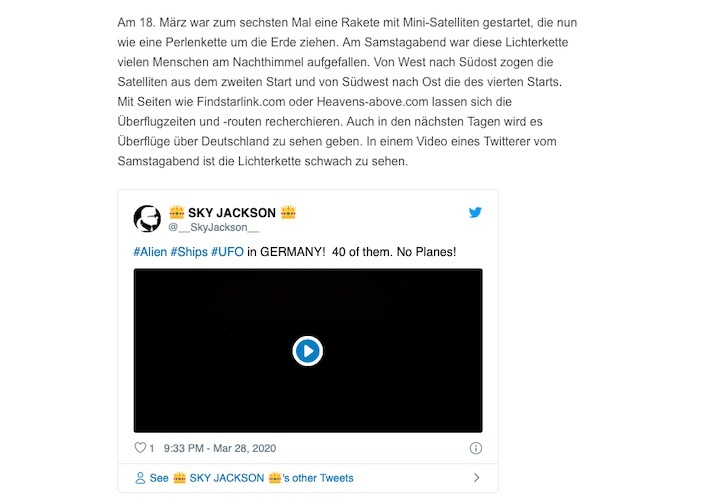
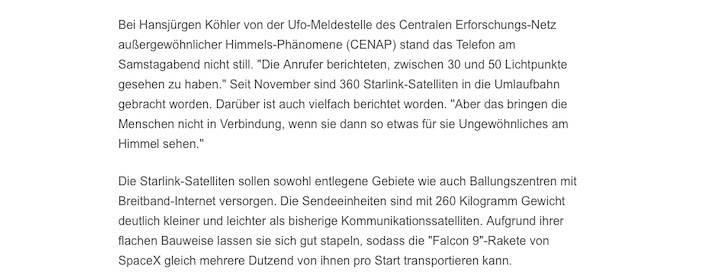
+++

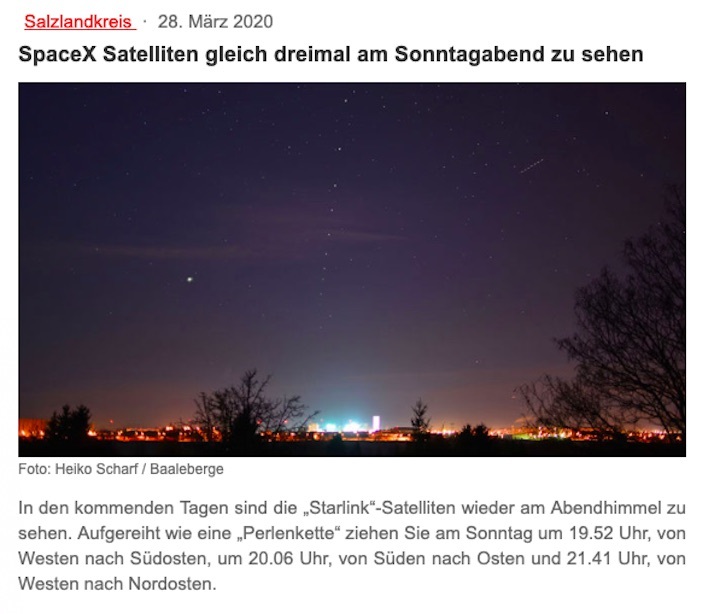
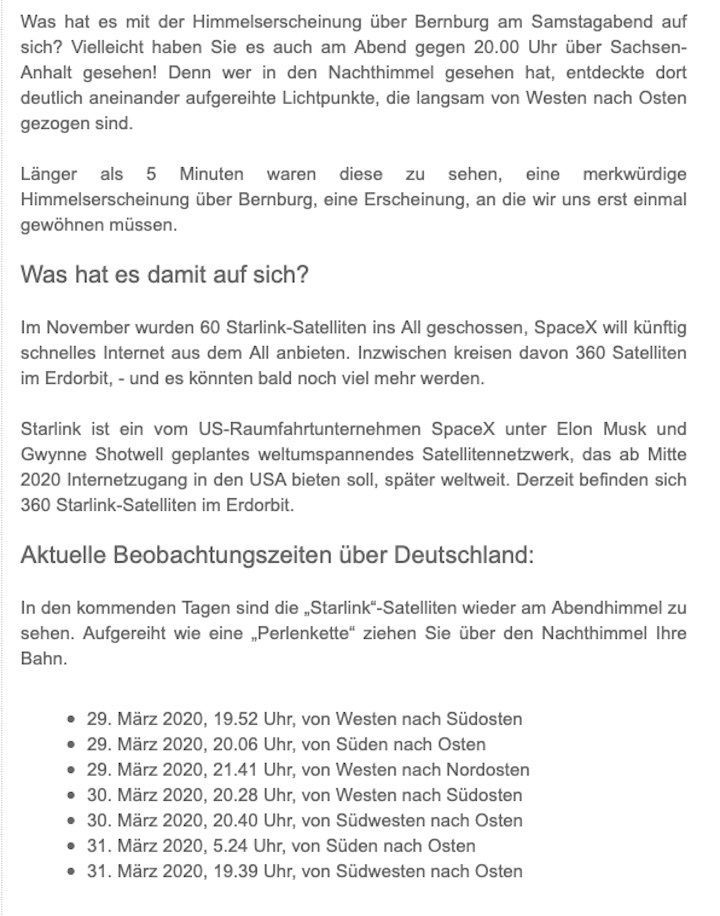
----
Update: 30.03.2020
.

30.03.2020
Und weiterhin erreichen uns Tel-Anrufe und E-Mails bei unserer UFO-Meldestelle zu den Starlink-Überflügen am Samstag aber auch zu Sonntag aus dem Norden von Deutschland da dort gegenüber dem restlichen Land bewölkter Himmel war.
Beobachtungen zu Samstag kamen noch aus: Bochum, Kaufbeuren, Gütersloh, Neuss, Bremen.
Beobachtungen zu Sonntag kamen aus: Heide-Meldorf, Gütersloh, Schwerin, Braunschweig, Rheine.
Stand: 8.30 MESZ
+++
Aufnahmen von Starlink-Satelliten-Überflügen aus England:
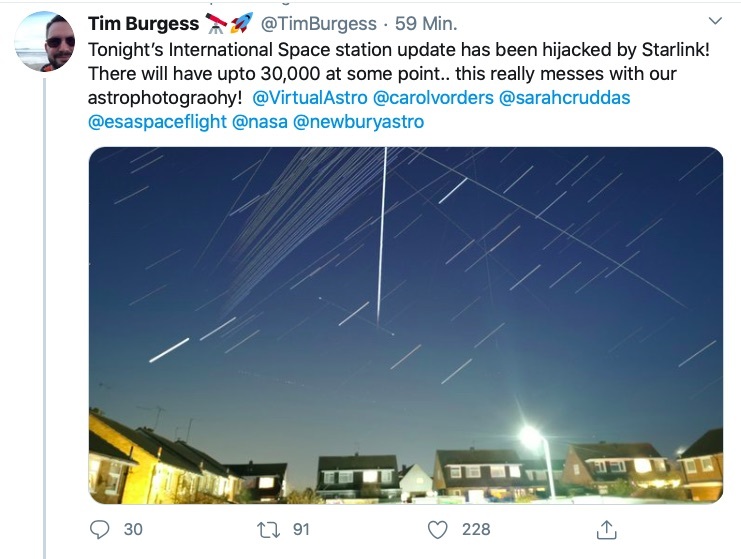
CENAP-Michelstadt
+++
... ein besorgter Tel-Anruf ging gegen 3.52 MESZ von einer jungen Dame ein, welche schon die ganze Nacht den Sternhimmel beobachte und ihr aufgefallen war das die Sterne "bunt blinkten" und ob sie sich Sorgen darüber mache müsse...
Erst dachte ich an einen Scherz, aber sie führte auch ihre Freundin auf welcher es ebenfalls aufgefallen sei und man es noch nicht so wahrgenommen hatte. Also erklärte ich die Ursache der Farbenspiele am Sternenhimmel und das man beruhigt sein könne und es normal wäre.
Im Nachhinein erinnerte ich mich an einen Post auf Twitter von "Aluhut" in welchem er einen Beitrag von esoterischen Ufologen gebracht hatte und in dem man verlautete, die am buntesten funkelnde Sterne wären die Mutterschiffe der Außerirdischen. Ist zwar eine der blöden Behauptungen der sektierischen Ufologen aber wenn sie nicht im Hinterzimmer sondern in der Öffentlichkeit gemacht werden fallen Leichtgläubige schnell darauf rein:

Und hier nochmal was sich wirklich hinter dem Funkeln verbirgt:
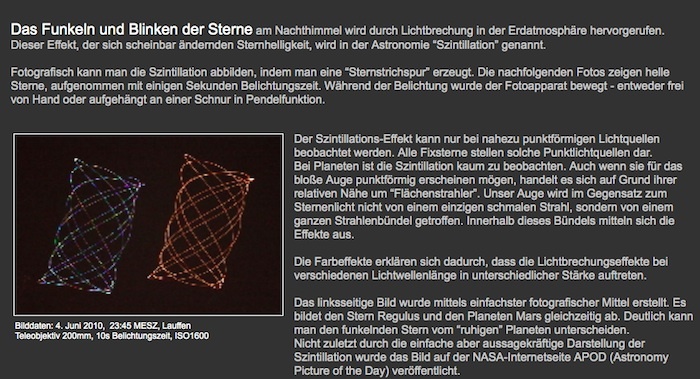
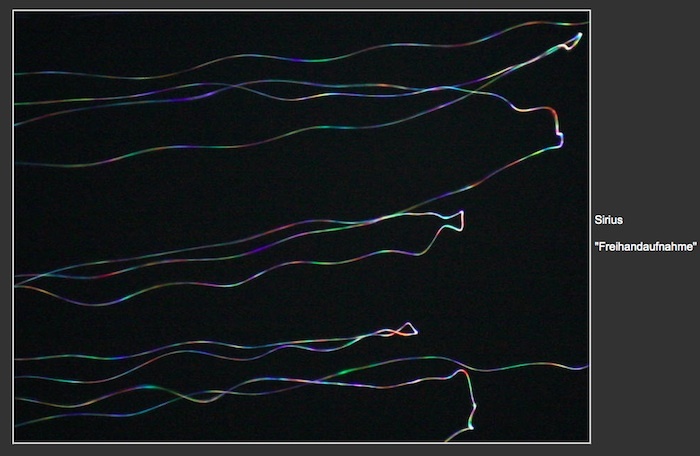
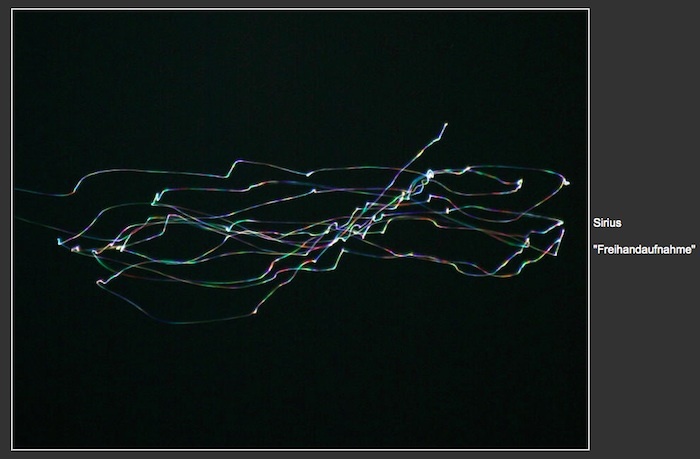
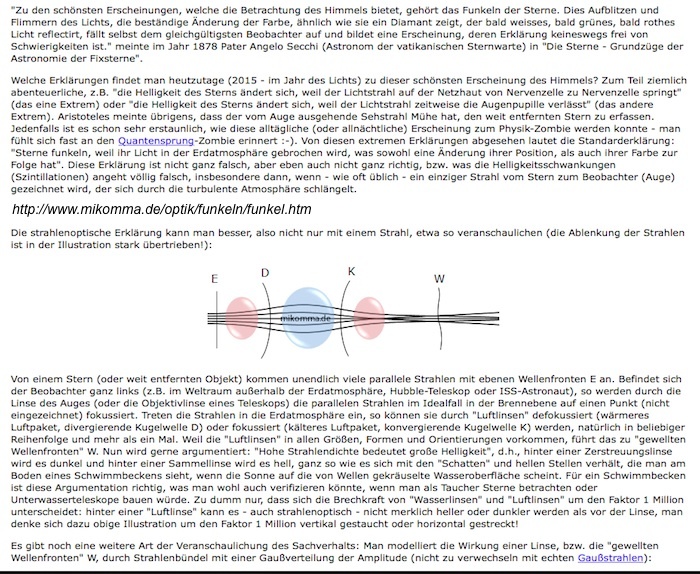
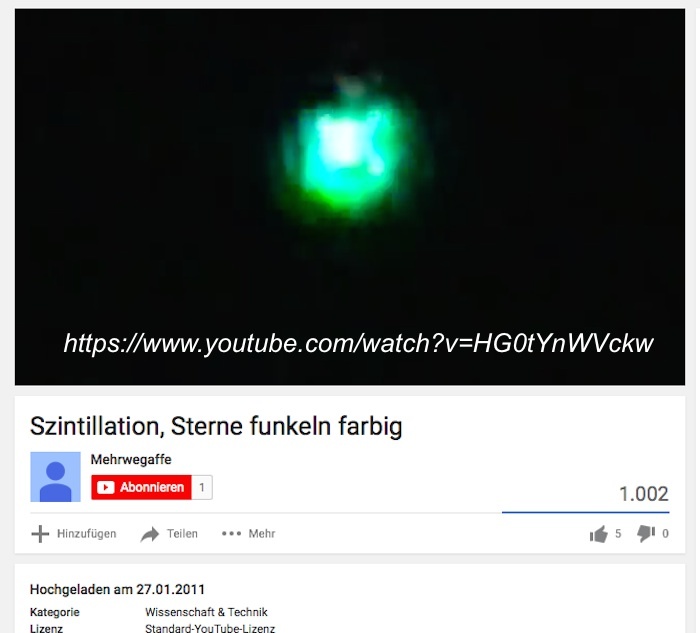
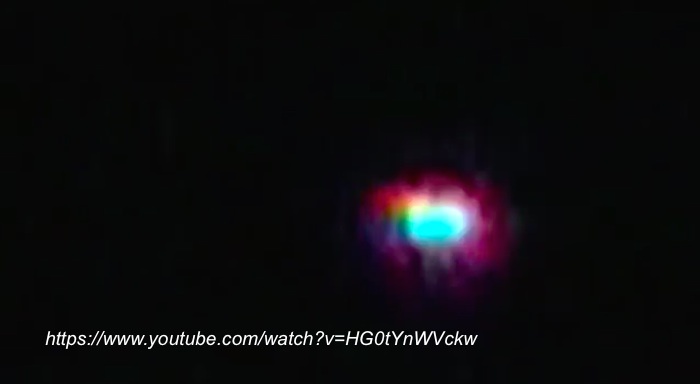
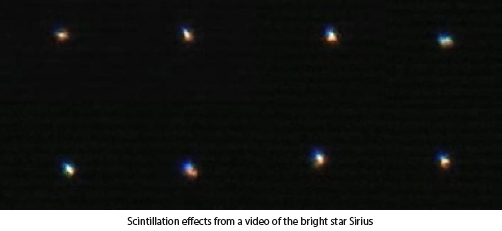
Quelle: cenap-archiv
+++
Update: 20.00 MESZ

Weitere Starlink-Satelliten Beobachtung ging im Laufe des Tages von Gestern bei unserer UFO-Meldestelle ein. Herr S. war überrascht mehrere Lichtpunkte wie Satelliten zu sehen, aber die Anzahl verunsicherte ihn und er nahm es per Handy-Video auf.
Nachfolgend zwei Screenshots aus dem Video, welches wir zu Referenzzwecken zur Verfügung gestellt bekamen:
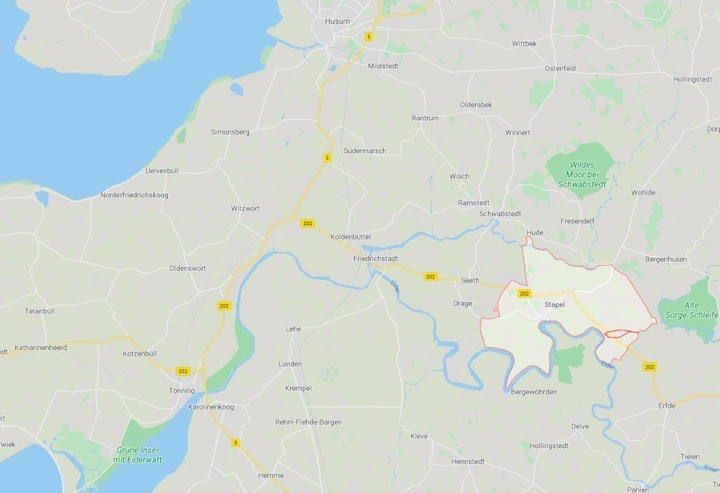
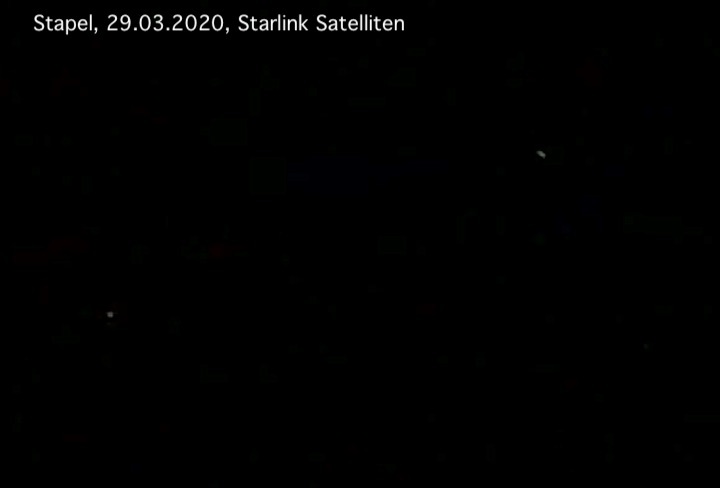
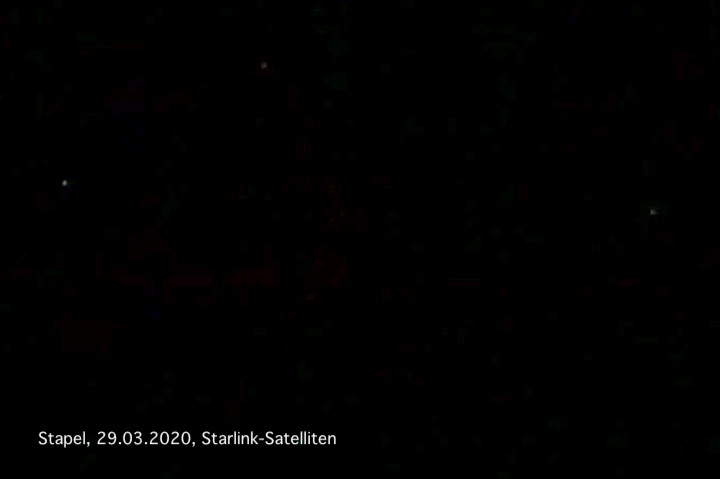
+++
Inzwischen bekommen wir weitere Meldungen zu heutigen Überflügen der Starlink-Satelliten aus
Ludwigslust bei Schwerin, Bremen, Schwarzenbek, Sandesneben, Nürnberg-Fürth, Ingolstadt,
Stand: 21.50 MESZ
CENAP-Michelstadt

